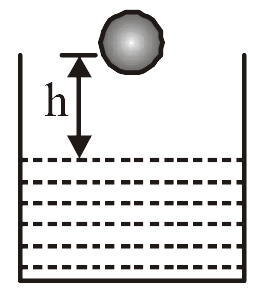A spherical ball of radius 3×10−4m and density 104kg/m3 falls freely under gravity through a distance h before entering a tank of water. If after entering the water the velocity of the ball does not change, find h the viscosity of water is 9.8×10−6N−s/m2
The correct Answer is:1.65×103m
To solve the problem step by step, we need to follow these steps:
Step 1: Understand the Forces Acting on the Ball
When the spherical ball enters the water, three forces act on it:
1. The gravitational force (weight) acting downwards: Fg=mg
2. The buoyant force acting upwards: Fb=ρwVg
3. The viscous force acting upwards: Fv=6πrηvt
At terminal velocity, the net force acting on the ball is zero, which means:
Fg−Fb−Fv=0
Step 2: Calculate the Mass of the Ball
The mass m of the ball can be calculated using its density and volume:
m=ρbV
Where:
- ρb=104kg/m3 (density of the ball)
- V=43πr3 (volume of the sphere)
Given r=3×10−4m:
V=43π(3×10−4)3=43π(27×10−12)=36π×10−12m3
Now, substituting in the mass:
m=104×36π×10−12=36π×10−8kg
Step 3: Calculate the Gravitational Force
The gravitational force acting on the ball is:
Fg=mg=(36π×10−8)g
Using g=10m/s2:
Fg=36π×10−8×10=36π×10−7N
Step 4: Calculate the Buoyant Force
The buoyant force is given by:
Fb=ρwVg
Where:
- ρw=103kg/m3 (density of water)
- V=36π×10−12m3
Thus,
Fb=103×36π×10−12×10=36π×10−9N
Step 5: Set Up the Equation for Terminal Velocity
At terminal velocity, the forces balance:
Fg−Fb−Fv=0
Substituting the forces:
36π×10−7−36π×10−9−6πrηvt=0
Step 6: Solve for Terminal Velocity
Rearranging gives:
36π×10−7−36π×10−9=6π(3×10−4)(9.8×10−6)vt
Factoring out 36π:
36π(10−7−10−9)=6π(3×10−4)(9.8×10−6)vt
Cancel π and simplify:
36(10−7−10−9)=6(3×10−4)(9.8×10−6)vt
Calculating 10−7−10−9=0.099×10−7:
36×0.099×10−7=6×3×10−4×9.8×10−6vt
Step 7: Calculate Terminal Velocity
Solving for vt:
vt=36×0.099×10−76×3×10−4×9.8×10−6
Calculating gives:
vt≈0.1836m/s
Step 8: Calculate the Height h
Using the equation of motion:
v2=u2+2gh
Where u=0:
(0.1836)2=0+2×10×h
h=(0.1836)220
Calculating gives:
h≈0.16868m
Final Answer
Thus, the height h from which the ball fell is approximately:
h≈1.6868m
---
When the spherical ball enters the water, three forces act on it:
1. The gravitational force (weight) acting downwards: Fg=mg
2. The buoyant force acting upwards: Fb=ρwVg
3. The viscous force acting upwards: Fv=6πrηvt
Fg−Fb−Fv=0
The mass m of the ball can be calculated using its density and volume:
m=ρbV
Where:
- ρb=104kg/m3 (density of the ball)
- V=43πr3 (volume of the sphere)
V=43π(3×10−4)3=43π(27×10−12)=36π×10−12m3
m=104×36π×10−12=36π×10−8kg
The gravitational force acting on the ball is:
Fg=mg=(36π×10−8)g
Using g=10m/s2:
Fg=36π×10−8×10=36π×10−7N
The buoyant force is given by:
Fb=ρwVg
Where:
- ρw=103kg/m3 (density of water)
- V=36π×10−12m3
Fb=103×36π×10−12×10=36π×10−9N
At terminal velocity, the forces balance:
Fg−Fb−Fv=0
Substituting the forces:
36π×10−7−36π×10−9−6πrηvt=0
Rearranging gives:
36π×10−7−36π×10−9=6π(3×10−4)(9.8×10−6)vt
36π(10−7−10−9)=6π(3×10−4)(9.8×10−6)vt
36(10−7−10−9)=6(3×10−4)(9.8×10−6)vt
36×0.099×10−7=6×3×10−4×9.8×10−6vt
Solving for vt:
vt=36×0.099×10−76×3×10−4×9.8×10−6
vt≈0.1836m/s
Using the equation of motion:
v2=u2+2gh
Where u=0:
(0.1836)2=0+2×10×h
h=(0.1836)220
h≈0.16868m
Thus, the height h from which the ball fell is approximately:
h≈1.6868m
Topper's Solved these Questions
- ELASTICITY, SURFACE TENSION AND FLUID MECHANICSBOOK - ALLENCHAPTER - ELASTICITY, SURFACE TENSION AND FLUID MECHANICSEXERCISE - Exercise 4 B (Bran storming Subjective Exercise)
15 Videos
- ELASTICITY, SURFACE TENSION AND FLUID MECHANICSBOOK - ALLENCHAPTER - ELASTICITY, SURFACE TENSION AND FLUID MECHANICSEXERCISE - Exercise 5 A (Previous year Questions)
29 Videos
- ELASTICITY, SURFACE TENSION AND FLUID MECHANICSBOOK - ALLENCHAPTER - ELASTICITY, SURFACE TENSION AND FLUID MECHANICSEXERCISE - Exercise 4 A (Fuild Dynamics)
7 Videos
- CENTRE OF MASSBOOK - ALLENCHAPTER - CENTRE OF MASSEXERCISE - EXERCISE-V B
19 Videos
- ERROR AND MEASUREMENTBOOK - ALLENCHAPTER - ERROR AND MEASUREMENTEXERCISE - Part-2(Exercise-2)(B)
22 Videos
Similar Questions
A spherical ball of radius 3.0×10−4m and density 104kg/m3 falls freely under gravity through a distance h before entering a tank of water. If after entering the water the velocity of the ball does not change, find h. Viscosity of water is 9.8×106N−s/m2.
View SolutionA spherical ball of radius 3.0×10−4 m and density 104kgm3 falls freely under gravity through a distance H=n×500m before entering a tank of water. If after enerting the water the velocity of the ball does not change, then find n. viscosity of water is 10×10−6N−sm2,g=10ms
View Solution
Knowledge Check
A metal ball ofradius 10−4 m and density 104kg/m3 falls freely under gravity through a distance 'h' and enters a tank of water. It is found that after entering the water, the velocity of ball does not change. What is the value of h?
[ηfor water 10−5 Pas ,g=10m/s2 and orhwater=103kg/m3]A10mB15mC18mD20mA drop of radius 2×10−5 and density 1.2×103kg/m3 falls through air. The viscosity of air is 1.8×10−5Ns/m2. Neglecting buoyancy due to air, the terminal speed of the drop is
A2.8cm/sB3.8cm/sC4.8cm/sD5.8cm/sA sphere of radius 10cm and density 500kg/m3 is under water of density 1000kg/m3 The acceleration of the sphere is 9.80m/s2 upward viscosity of water is 1.0 centipoise if g=9.81m/s2 the velocity of the sphere is
A9m/sB10m/sC11m/sD12m/s
A small ball of radius 'r' falls freely under gravity through a distance 'h' before entering a tank of water. If after entering the water, the velocity of ball does not change, the 'h' is proportional to
View SolutionA small ball of radius 'r' falls freely under gravity through a distance 'h' before entering a tank of water. If after entering the water, the velocity of ball does not change, the 'h' is proportional to
View SolutionA ball of radius r and density r falls freely under gravity through a distance h before entering water. Velocity of ball does not change even on entering water. If viscosity of water is η the value of h is given by

View SolutionIn an experiment to verify Stokes law , a small spherical ball of radius r and density ρ falls under gracvity throught a distance h in air before entering a tank of wate . If the terminal velocity of the ball inside water is same as its velocity just befor entering the water surface , then the value of h is proportional to : ( ignore viscosity of air ) .
View SolutionA metallic sphere of radius 1.0×10−3m and density 1.0×104kg/m3 enters a tank of water, after a free fall through a distance of h in the earth's gravitational field. If its velocity remains unchanged after entering water, determine the value of h. Given: coefficient of viscosity of water =1.0×10−3Ns/m2,g=10ms−12 and density of water =1.0×103kg/m3.
View Solution
